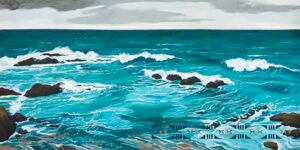 Over a career spanning six decades, Kay WalkingStick’s practice has focused on the American landscape and its significance to the country’s first inhabitants. In the 1980s, after spending time in the Colorado Rockies, she became enamored with the landscape and felt compelled to depict it by combining abstraction and realism in pairs of paintings that she joined together as diptychs (two-part paintings). As WalkingStick describes it, “the diptych is an especially meaningful metaphor to express the beauty and power of uniting the disparate, and this makes it particularly attractive to those of us who are biracial. It also visualizes the connection between our sacred earth and the cosmos, reminding us of the need to protect our planet.”
Over a career spanning six decades, Kay WalkingStick’s practice has focused on the American landscape and its significance to the country’s first inhabitants. In the 1980s, after spending time in the Colorado Rockies, she became enamored with the landscape and felt compelled to depict it by combining abstraction and realism in pairs of paintings that she joined together as diptychs (two-part paintings). As WalkingStick describes it, “the diptych is an especially meaningful metaphor to express the beauty and power of uniting the disparate, and this makes it particularly attractive to those of us who are biracial. It also visualizes the connection between our sacred earth and the cosmos, reminding us of the need to protect our planet.”
In her most recent works, WalkingStick overlays paintings with the designs of the Native American people who have inhabited or live in the landscape shown. Seal Rock Storm depicts the stormy coastal waters of Aquidneck, Rhode Island, and is one of very few seascapes she has painted. On the lower-right panel, WalkingStick includes patterns found on the basketry of the Pequot peoples, who are native to Rhode Island and Connecticut. Amid the dramatic ocean and crashing waves, this gesture emphasizes the Indigenous traditions of abstraction that have thrived for generations and reaffirms the presence of the Indigenous peoples who have long inhabited this coast.
Kay WalkingStick (born 1935), Seal Rock Storm. Oil on panel in two parts, 2023. 40 × 80 in. (101.6 × 203.2 cm). Purchased with funds from the Libbey Endowment, Gift of Edward Drummond Libbey, 2024.4. On view in Gallery 6.
Source: www.toledomuseum.org

